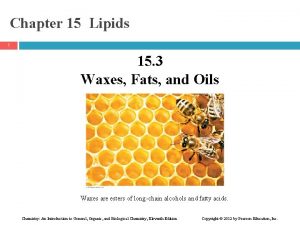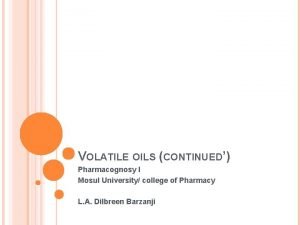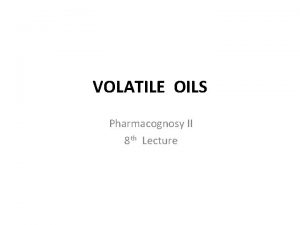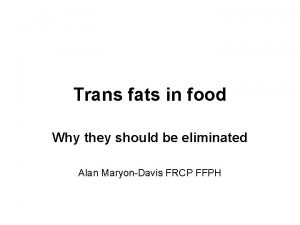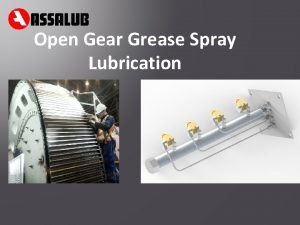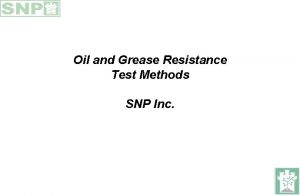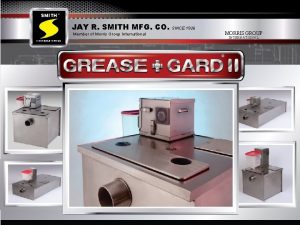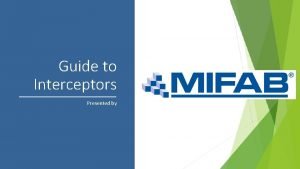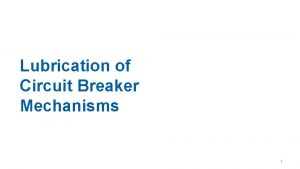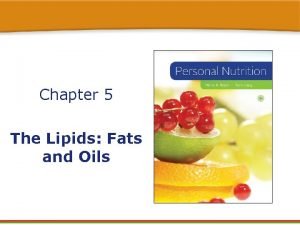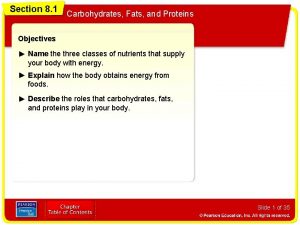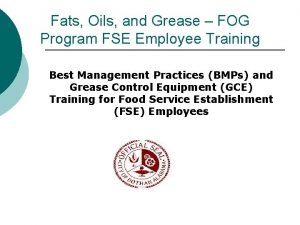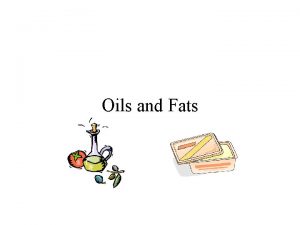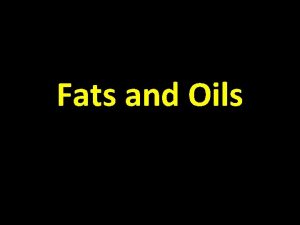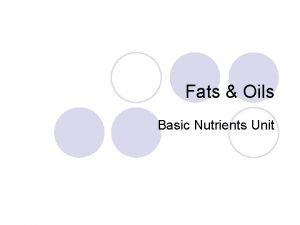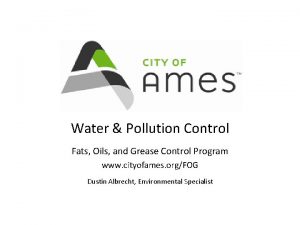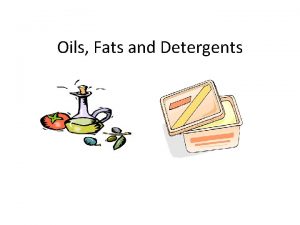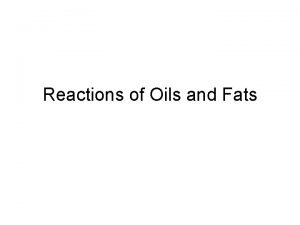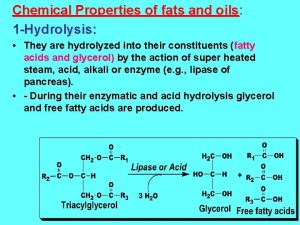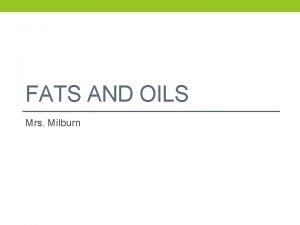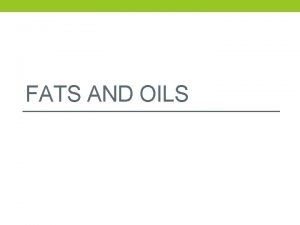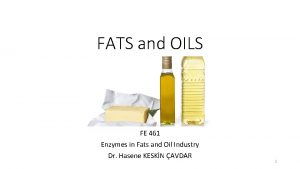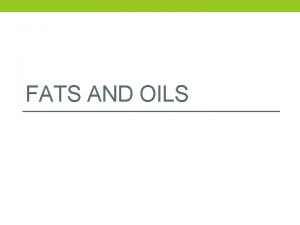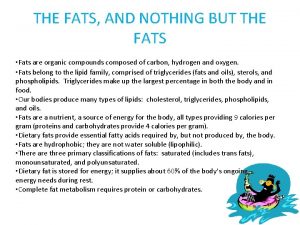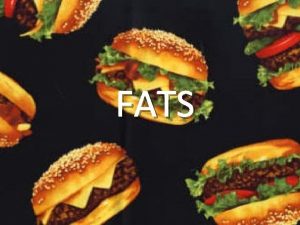Fats Oils and Grease FOG Program FSE Employee





































- Slides: 37

Fats, Oils, and Grease – FOG Program FSE Employee Training Best Management Practices and Grease Control Device Maintenance for Food Service Establishment Employees

FOG Program FSE Employee Training – Goals and Outcomes ¡ ¡ ¡ Fully understand how using kitchen BMPs to control FOG discharge is related to sewer blockages and Sanitary Sewer Overflows. Be able to properly clean and maintain a grease control device up to 50 GPM (100 lb) in accordance with the FOG Ordinance. Understand background and purpose for the FOG Program. Understand the responsibility of the FSE for illicit FOG discharge. Three (3) year certification with the FOG program.

What is FOG? Fats, Oils, and Grease ¡ Any combination of animal fats and/or vegetable oils that are used to prepare food, or are found in food. ¡

The FOG Problem… ¡ ¡ When discharged into sewer lines, FOG accumulates and sticks to pipe walls causing clogs in the sanitary sewer system. Significant sources of FOG are residential homes and Food Service Establishments (FSEs), where cooking oil and residual food grease from dishes is improperly disposed of in drains.

The FOG Problem… City-owned Stormwater Sewer System Food Service Establishment City-owned Sanitary Sewer System

Sewers and Sewage Disposal FOG Ordinance Federal and State mandates require the prevention of Sanitary Sewer Overflows (SSOs). ¡ The Fats, Oils, and Grease Ordinance is one measure providing adequate regulation to enforce maintenance of grease control devices. ¡

The FOG Program Objectives Reduce FOG-related Sanitary Sewer Overflows ¡ Provide increased education and awareness of FOG and to improve FOG remediation efforts at FSEs. ¡ FOG discharge and related SSOs are NO accident!

The Human Example ¡ ¡ Sanitary sewer system = human body Sewer pipe network = arteries Pump stations = heart Wastewater treatment plant = kidneys

The Human Example Wastewater Treatment Plant Pump Station Sewer Pipe Network Food Service Establishments

The Human Example ¡ ¡ FOG flows through the sanitary sewer system much like bad cholesterol and fatty acids in the human body (which cause “hardening of arteries”). FOG can accumulate and constrict flow and potentially cause blockages similar to plaque build up in blood vessels.

The Human Example ¡ Just like the human body, the best way to prevent FOG buildup is to avoid introducing FOG into the sanitary sewer system. ¡ ¡ Kitchen BMPs used everyday can significantly reduce FOG buildup. BMPs are like “diet and exercise” for the sanitary sewer system, replacing bad habits with good.

Remember … ¡ Sanitary Sewage Overflows that result from FOG discharge are violations of State and Federal Law.

Understanding FOG Sources ¡ Understand the sources of FOG in a kitchen.

Understanding FOG Sources Fatty foods ¡ Cooking oils ¡ Residual food debris ¡ Kitchen utensils ¡ Dinnerware ¡ Deep Fryers ¡ Leftovers ¡

Understanding FOG Sources ¡ FSEs primarily generate… l l ¡ ¡ Brown Grease Yellow Grease Even though all grease has the same effect when discharged into the sanitary sewer system, maintenance measures may vary depending on the different types of FOG generated. Separate yellow and brown grease disposal is required.

Important “Take Away” Points FOG discharge and related SSOs are NO accident! ¡ Illicit FOG discharge causes “hardening of arteries” for the sanitary sewer system. ¡ Kitchen BMPs act as “diet and exercise” for the sanitary sewer system. ¡ FOG is generated by various sources from within the FSE. ¡

Reducing FOG from FSEs ¡ Use FOG Best Management Practices.

Reducing FOG from FSEs ¡ Post “No-Grease” Signs Over Sinks

Reducing FOG from FSEs Scrape food from dirty dishes, pots, and pans into a trash can, then dry -wipe them with a paper towel. ¡ FOG should not be discarded into garbage disposals. ¡

Reducing FOG from FSEs ¡ Clean and maintain kitchen fixtures regularly or as required to control FOG buildup.

Reducing FOG from FSEs ¡ ¡ Use the smallest quantity of chemicals and soap possible to maintain a sanitary kitchen. Too much use of a cleaning product can allow the FOG to pass beyond grease traps and interceptors.

Reducing FOG from FSEs City-owned Stormwater Sewer System Food Service Establishment City-owned Sanitary Sewer Systems

Reducing FOG from FSEs ¡ ¡ ¡ Put yellow grease in a grease recycling bin, usually located outside the FSE. Keep the lid on the grease bin closed so that rainwater does not get in. Spills or overflows from FOG containers and dumpsters are extremely damaging to the stormwater system and harmful to the environment. NEVER pour or dispose of grease, oil, food debris, or trash into a grease control device!

Reducing FOG from FSEs ¡ ¡ Call the company that is responsible for removing the grease and ask them to empty the bin before the receptacle is full. NEVER pour or dispose of FOG, food debris, or trash into the storm water system!

Reducing FOG from FSEs ¡ Clean kitchen floor mats inside over a mop sink or a utility sink.

Grease Control Devices ¡ ¡ ¡ “Last line of Defense” against illicit FOG discharge. Install, register, and regularly maintain grease traps and interceptors. This keeps wastewater from backing up and overflowing into the FSE and also keeps FOG from damaging the sanitary sewer system.

Grease Interceptors ¡ ¡ ¡ Most grease interceptors are located outside of the FSE, underground. A grease hauler must be hired to clean a grease interceptor. If possible, watch the grease hauler to make sure that the interceptor is completely cleaned and free of FOG buildup.

Grease Traps ¡ ¡ ¡ Grease traps are generally located underneath sinks. FSE employees may clean grease traps. Grease Control Devices over 50 GPM (100 lb) in size must be cleaned by an approved grease hauler.

Grease Trap Cleaning Baffles Fixture for food debris

Grease Trap Cleaning Clean out the grease trap ENTIRELY. ¡ Remove the baffle. ¡ Scrape the baffle and inside walls of the tank to remove FOG buildup. ¡ Dry wipe the trap rather than using water and cleaning chemicals. ¡

Grease Trap Cleaning Trap should be placed so that it is easy to open and clean. ¡ The grease that is cleaned out should be placed into a container and disposed of in the trash. ¡ Frequent skimming of the trap makes it easier to clean later. ¡

Grease Trap Cleaning ¡ A grease trap should be cleaned out completely when about a quarter of its volume is FOG and solids. ¡ The grease trap should be checked every day to make sure it does not need to be cleaned, and it must be cleaned a minimum of once per week.

Maintenance Logs ¡ ¡ After cleaning out a grease trap, remember to enter the information into the GCD maintenance log. If a grease hauler cleaned out the trap or interceptor, put the grease hauler’s manifest into the maintenance log. The date and approximate volume of FOG waste removed should be recorded. GCD maintenance documents are to be kept on site at the FSE for three (3) years.

Recap: Expectations from Training FOG discharge and related SSOs are NO accident! ¡ Illicit FOG discharge causes “hardening of arteries” for the sanitary sewer system. ¡ Kitchen BMPs act as “diet and exercise” for the sanitary sewer system. ¡ FOG is generated by various sources from within the FSE. ¡

Recap: Expectations from Training Grease Control Devices are the “last line of defense” against illicit FOG discharge. ¡ NEVER discard grease into storm drains. ¡ NEVER discard grease directly into a Grease Control Device ¡ Food Service Establishments are responsible for illicit FOG discharge. ¡

Reducing FOG from FSEs ¡ ¡ ¡ Kitchen BMPs Installed and properly maintained GCDs Prevent SSOs, maintain function of sanitary sewer system, and protect stormwater system and surrounding habitat. City owned Stormwater Sewer System Food Service Establishment City owned Sanitary Sewer System

Fats, Oil, and Grease Program ¡ ¡ By following these guidelines, backups into the restaurant and damage from FOG to the sanitary sewer system is easily avoidable. For more information regarding FOG or the FOG program, contact… Department of Public Utilities FOG Program 6582 Main Street PO Box 329 Gloucester, VA 23061 FOG@gloucesterva. info
 Is lipid long term energy
Is lipid long term energy Fats, oils, and waxes
Fats, oils, and waxes Fatty acids definition
Fatty acids definition What biomolecule transports substances in and out of cells
What biomolecule transports substances in and out of cells Fats spreads and oils
Fats spreads and oils Non polar molecules that include fats oils and cholesterol
Non polar molecules that include fats oils and cholesterol Fog types aviation
Fog types aviation Advection fog vs radiation fog
Advection fog vs radiation fog Advection fog vs radiation fog
Advection fog vs radiation fog Employee attitudes and employee performance
Employee attitudes and employee performance Fse kaj lazi po tem sveti besedilo
Fse kaj lazi po tem sveti besedilo Courbe perfusion irm parotide
Courbe perfusion irm parotide El fse invierte en tu futuro
El fse invierte en tu futuro El fse invierte en tu futuro
El fse invierte en tu futuro Fse ovidius
Fse ovidius Blackening in firearm injury
Blackening in firearm injury Fog program software
Fog program software Definition of volatile oil in pharmacognosy
Definition of volatile oil in pharmacognosy Volatile oils pharmacognosy
Volatile oils pharmacognosy Brian peskin
Brian peskin New age oils
New age oils Thieves cleaner packets
Thieves cleaner packets Essential oils for pelvic congestion syndrome
Essential oils for pelvic congestion syndrome Hydrogenation of oils
Hydrogenation of oils Owensboro grain edible oils
Owensboro grain edible oils Yellow grease biodiesel
Yellow grease biodiesel Green turtle grease interceptor
Green turtle grease interceptor Grease spray nozzle
Grease spray nozzle 3m kit test grease resistance
3m kit test grease resistance Jr smith grease interceptor
Jr smith grease interceptor Deletion indicators cryptic
Deletion indicators cryptic An egg fried in one side with hot grease spooned over top
An egg fried in one side with hot grease spooned over top Fixture units uniform plumbing code
Fixture units uniform plumbing code Circuit breaker lubrication
Circuit breaker lubrication Grease grade chart
Grease grade chart Section 8-1 carbohydrates fats and proteins answer key
Section 8-1 carbohydrates fats and proteins answer key Saturated vs unsaturated fatty acids
Saturated vs unsaturated fatty acids Section 8-1 summary carbohydrates fats and proteins
Section 8-1 summary carbohydrates fats and proteins

